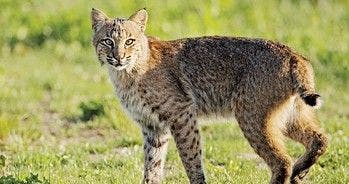Home & Garden
DEEP: Bobcat Sightings Are Common in Manchester
Residents of Tolland and Hartford counties can certainly see a bobcat at any time, environmental officials said.

Bobcats in Connecticut? Well ... that's correct.
They are plentiful in the state and certainly can be seen in Hartford and Tolland counties, according to Dennis Schain, a spokesman for the state Department of Energy and Environmental Protection.
"Bobcats are beautiful animals and we should enjoy them from a distance. We can see them everywhere," he said.
Find out what's happening in Manchesterwith free, real-time updates from Patch.
But the glimpse could be fleeting.
"You might not see them for very long because they are quick," Schain said.
Find out what's happening in Manchesterwith free, real-time updates from Patch.
According to the DEEP's bobcat fact sheet, the bobcat is the only wild cat found in Connecticut and the most common wild cat in North America.
Its status has changed dramatically in the state, according to the DEEP. Historically, bobcats were not protected in Connecticut and were viewed as a threat to agriculture and game species. The state even had a bounty on bobcats from 1935 to 1971, according to the DEEP.
By the early 1970s, a large increase in the value of bobcat pelts raised concerns that the population could be threatened.
In addition, deforestation of the state’s landscape that peaked in the 1800s greatly reduced habitat for bobcats and many other wildlife species. In 1972, the bobcat was reclassified as a protected furbearer in Connecticut with no hunting or trapping seasons, according to the DEEP.
Based on observation reports submitted to the Wildlife Division by the public and others, bobcat numbers appear to have increased in Connecticut in recent years and sighting and vehicle-kill reports indicate that bobcats now reside in all eight Connecticut counties, according to the DEEP.
The bobcat is a stout-bodied, medium-sized feline, with a short, “bobbed” tail (about 6 inches in length), prominent cheek ruffs, and tufts of black hair on its pointed ears, according to the DEEP.
The sides and back are generally the same color with faint black spots; grayer in winter and tan in summer, according to the DEEP. The underparts are white, the tail may have one to several indistinct dark bands and a tip that is black on top and whitish below, according to the DEEP.
Adult males typically weigh between 18 and 35 pounds and measure from 32 to 37 inches in length. Adult females typically weigh between 15 and 30 pounds and measure from 28 to 32 inches in length.
Bobcats are about two to three times the size of their distant relative, the domestic house cat, and the tracks of a young bobcat are often confused with those left by a roaming house cat, according to the DEEP.
Adult house cat tracks, however, are much smaller than adult bobcat tracks, according to the DEEP. Bobcat tracks have an overall round appearance with four round toe pads in both front and rear prints, according to the DEEP.
There is a fifth toe on the forefoot; however, it does not leave an impression because it is raised high on the foot. The claws do not leave an impression because they are usually retracted, according to the DEEP.
Bobcat attacks on people are extremely rare. Bobcats are not a significant vector of disease and rarely contract the mid-Atlantic strain of rabies, according to the DEEP.
DEEP officials said the agency's Wildlife Division continues to record bobcat sightings and also document the number of bobcats hit and killed by vehicles on Connecticut roadways.
Bobcat sightings can be reported to the Wildlife Division at [email protected] or by calling 860-424-3011. Those reporting sightings should include their names, contact information and the date, location, and time of sightings.
Bobcats are active during the winter, Schain said.
Photo Credit: Paul Fusco, DEEP Wildlife Division
Get more local news delivered straight to your inbox. Sign up for free Patch newsletters and alerts.